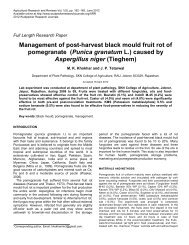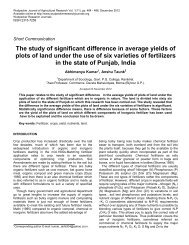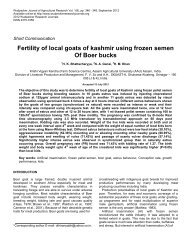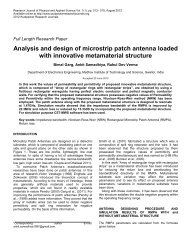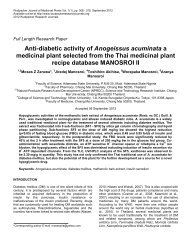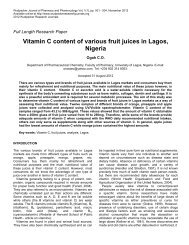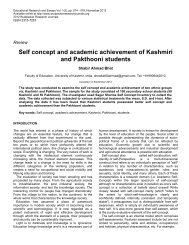Role of algae and cyanobacteria in sustainable ... - Wudpecker
Role of algae and cyanobacteria in sustainable ... - Wudpecker
Role of algae and cyanobacteria in sustainable ... - Wudpecker
You also want an ePaper? Increase the reach of your titles
YUMPU automatically turns print PDFs into web optimized ePapers that Google loves.
<strong>Wudpecker</strong> Journal <strong>of</strong> Agricultural Research Vol. 1(9), pp. 381 - 388, October 2012<br />
Available onl<strong>in</strong>e at http://www.wudpeckerresearchjournals.org<br />
2012 <strong>Wudpecker</strong> Research Journals<br />
ISSN 2315-7259<br />
Full Length Research Paper<br />
<strong>Role</strong> <strong>of</strong> <strong>algae</strong> <strong>and</strong> <strong>cyanobacteria</strong> <strong>in</strong> susta<strong>in</strong>able<br />
agriculture system<br />
Radheyshyam Sharma*, M.K. Khokhar**, R.L. Jat *** <strong>and</strong> S.K. Kh<strong>and</strong>elwal<br />
*Dept. <strong>of</strong> Molecular Biology <strong>and</strong> Biotechnology **Dept. <strong>of</strong> Plant Pathology *** Dept. <strong>of</strong> Agronomy, Rajasthan College <strong>of</strong><br />
Agriculture, Maharana Pratap University <strong>of</strong> Agriculture <strong>and</strong> Technology, Udaipur-313001 (Rajasthan) India.<br />
Accepted 01 September 2012<br />
Algae are very large <strong>and</strong> diverse group <strong>of</strong> simple, typically autotrophic organisms that can carried out<br />
photosynthesis <strong>and</strong> have ability to capture energy from sunlight. Algae play an important role <strong>in</strong><br />
susta<strong>in</strong>able <strong>and</strong> organic agriculture where it is used as bi<strong>of</strong>ertilizer <strong>and</strong> soil stabilizers. Algae,<br />
particularly the seaweeds, are used as fertilizers, result<strong>in</strong>g <strong>in</strong> less nitrogen <strong>and</strong> phosphorous run<strong>of</strong>f<br />
than the other from the use <strong>of</strong> livestock manure. This <strong>in</strong> turn, <strong>in</strong>creases the quality <strong>of</strong> water flow<strong>in</strong>g <strong>in</strong>to<br />
rivers <strong>and</strong> oceans. These organisms are cultivated around the world <strong>and</strong> used as human food<br />
supplements. They can produce a clean <strong>and</strong> carbon-neutral food also <strong>and</strong> can be grown on ab<strong>and</strong>oned<br />
l<strong>and</strong>s <strong>and</strong> arid desert l<strong>and</strong>s with m<strong>in</strong>imal dem<strong>and</strong>s for fresh water. Seaweeds are an important source <strong>of</strong><br />
iod<strong>in</strong>e <strong>and</strong> rich source <strong>of</strong> several prote<strong>in</strong> <strong>and</strong> vitam<strong>in</strong>s. Thus it is also a supplement food for animal feed<br />
<strong>and</strong> aquatic flora. In this review, we emphasize the critical aspects <strong>of</strong> <strong>algae</strong> <strong>and</strong> its agricultural uses.<br />
Key words: Algae, seaweeds, agriculture, bi<strong>of</strong>ertilizer, soil stabilizers.<br />
INTRODUCTION<br />
The assemblage <strong>of</strong> plant-like forms which are collectively<br />
referred to as <strong>algae</strong> <strong>in</strong>cludes a tremendously diverse<br />
group <strong>of</strong> organisms. Algae may range <strong>in</strong> size from s<strong>in</strong>gle<br />
cells as small as one micrometer to large seaweeds that<br />
may grow to over the plant surface (Vymazal, 1995).<br />
Many <strong>of</strong> the unicellular forms are motile, <strong>and</strong> soil borne<br />
(South <strong>and</strong> Whittick, 1987). Algae are ubiquitous; they<br />
occur <strong>in</strong> almost every habitable environment on earth, <strong>in</strong><br />
soils, permanent ice, snow fields, hot spr<strong>in</strong>gs, <strong>and</strong> hot<br />
<strong>and</strong> cold deserts. They are photosynthetic like plants,<br />
(Figure 1) <strong>and</strong> simple because their tissues are not<br />
organized <strong>in</strong>to the many dist<strong>in</strong>ct organs found <strong>in</strong>l<strong>and</strong><br />
plants.<br />
The largest <strong>and</strong> most complex mar<strong>in</strong>e forms are<br />
called seaweeds. Algae possess chlorophyll-a,b,c <strong>and</strong><br />
have carbohydrate, prote<strong>in</strong> <strong>and</strong> products comparable to<br />
those <strong>of</strong> higher plants. Algae are the major primary<br />
producers <strong>of</strong> organic compounds <strong>and</strong> play a middle role<br />
as the base <strong>of</strong> the food cha<strong>in</strong> <strong>in</strong> aquatic systems. They<br />
also produce the oxygen necessary for the metabolism <strong>of</strong><br />
the consumer organisms (Lee et al., 1989). Furthermore,<br />
*Correspond<strong>in</strong>g author E-mail: khokharmk3@gmail.com.<br />
their distribution <strong>and</strong> condition may <strong>in</strong>volve the<br />
ma<strong>in</strong>ta<strong>in</strong><strong>in</strong>g the ecological balance <strong>of</strong> the environment.<br />
Additionally, the presence <strong>of</strong> <strong>algae</strong> leads to reduced<br />
erosion by regulat<strong>in</strong>g the water flow <strong>in</strong>to soils. Similarly,<br />
they play a role <strong>in</strong> soil fertility, soil reclamation, biocontroll<strong>in</strong>g<br />
<strong>of</strong> agricultural pests, formation <strong>of</strong><br />
microbiological crust, agricultural wastewater treatment<br />
<strong>and</strong> recycl<strong>in</strong>g <strong>of</strong> treated water. The agriculture production<br />
totally depends on the fertility level <strong>of</strong> the soil. Like other<br />
organisms, <strong>algae</strong> which are found <strong>in</strong> different soil types,<br />
may help the soil to improve its characteristics such as,<br />
carbon content, texture, aeration (Ibraheem, 2007) <strong>and</strong><br />
also nitrogen fixation (Hamed, 2007).<br />
The magnitude <strong>of</strong> these improvements is greatly<br />
dependent on the physical <strong>and</strong> chemical characteristics<br />
<strong>of</strong> the soil, affect<strong>in</strong>g the composition <strong>of</strong> the algal<br />
population (Abdel-Raouf et al., 2004). Mar<strong>in</strong>e <strong>algae</strong> are<br />
used as bi<strong>of</strong>ertilizers on farml<strong>and</strong>s near to the sea. The<br />
weed is usually applied direct <strong>and</strong> ploughed <strong>in</strong>, both as<br />
solid <strong>and</strong> as liquid fertilizer (concentrated extract <strong>of</strong><br />
seaweeds) (Round, 1973). People’s uses <strong>of</strong> <strong>algae</strong> are far<br />
more diverse <strong>and</strong> economically important than generally<br />
realized (Abbott <strong>and</strong> Cheney, 1982). They are used as<br />
human food, <strong>in</strong> agriculture (fertilizer, manure, fodder <strong>and</strong><br />
aquaculture), medic<strong>in</strong>e, textile, paper <strong>and</strong> pa<strong>in</strong>t
Figure 1. Three-dimensional, multicellular thallus <strong>of</strong> Blue green <strong>algae</strong> genus<br />
Anabaena species Anabaena aequalis.<br />
<strong>in</strong>dustries, chemical extracts from larger mar<strong>in</strong>e <strong>algae</strong><br />
(example alg<strong>in</strong>ic acid , carrageenan or agar) are used <strong>in</strong><br />
the manufacture <strong>of</strong> food <strong>in</strong>dustry, <strong>and</strong> diatomaceous<br />
earth (deposits <strong>of</strong> diatom frustules) is widely used as<br />
filtration <strong>and</strong> polish<strong>in</strong>g materials. Algae are also important<br />
surface-b<strong>in</strong>d<strong>in</strong>g agents which reduce erosion <strong>and</strong> can be<br />
used for wastewater treatment.<br />
Cyanobacteria are a diverse group <strong>of</strong> prokaryote which<br />
is similar to that <strong>in</strong> <strong>algae</strong> <strong>and</strong> higher plants due to their<br />
oxygenic photosynthesis ability. As sunlight is their<br />
energy source <strong>and</strong> water, they generate oxygen <strong>in</strong> the<br />
light. Energy <strong>and</strong> reductants generated by photosynthesis<br />
are usually used for carbon dioxide reduction. These<br />
microorganisms are distributed worldwide <strong>and</strong> improve<br />
the growth <strong>and</strong> development <strong>of</strong> the plants, with which<br />
they share the habitat, because they:<br />
1) contribute to soil fertility <strong>in</strong> many ecosystems;<br />
2) produce various biologically active substances <strong>and</strong><br />
3) have higher efficiency <strong>in</strong> biosorption <strong>of</strong> heavy metals<br />
(bioremediation) (Ibraheem, 2007).<br />
Diazotrophic <strong>cyanobacteria</strong> require sunlight as a sole<br />
energy source for the fixation <strong>of</strong> carbon <strong>and</strong> nitrogen.<br />
Therefore, they have great potential as bi<strong>of</strong>ertilizers, <strong>and</strong><br />
their use will decrease fuel dem<strong>and</strong> for fertilizer<br />
production. The agronomic potential <strong>of</strong> heterocystous<br />
<strong>cyanobacteria</strong>, either free-liv<strong>in</strong>g or <strong>in</strong> symbiotic<br />
association with water fern Azolla (El-Zeky et al., 2005).<br />
Cyanobacteria are congenial bi<strong>of</strong>ertilizers for rice based<br />
cropp<strong>in</strong>g systems, be<strong>in</strong>g the major components <strong>of</strong><br />
wetl<strong>and</strong> rice ecosystems which are easily available <strong>and</strong><br />
serve as the cheapest sources <strong>of</strong> natural bi<strong>of</strong>ertilizers<br />
(Ladha <strong>and</strong> Reddy, 2003).<br />
IMPROVEMENT OF SOIL FERTILITY<br />
Sharma et al. 382<br />
Some <strong>cyanobacteria</strong> are able to reduce atmospheric<br />
nitrogen to ammonia, a process where oxygen evolved<br />
by photosynthetic activity <strong>in</strong> the same cell is detrimental<br />
to nitrogen fixation. Now a day’s strategies to avoid<br />
oxygen range from temporal separation <strong>of</strong> nitrogen<br />
fixation <strong>and</strong> oxygen evolution to spatial separation <strong>and</strong><br />
cellular differentiation <strong>in</strong>to nitrogen fix<strong>in</strong>g heterocysts (<strong>in</strong><br />
filamentous <strong>cyanobacteria</strong>). Heterocysts are term<strong>in</strong>ally<br />
differentiated cells whose <strong>in</strong>terior becomes anaerobic,<br />
ma<strong>in</strong>ly as a consequence <strong>of</strong> respiration, allow<strong>in</strong>g the<br />
oxygen-sensitive process <strong>of</strong> nitrogen fixation to cont<strong>in</strong>ue.<br />
The regulation <strong>of</strong> d<strong>in</strong>itrogen fixation has been extensively<br />
studied <strong>in</strong> the heterocyst system.<br />
Uptake <strong>of</strong> N <strong>and</strong> P<br />
Cyanobacteria also have some soil phosphatesolubiliz<strong>in</strong>g<br />
species. Phosphorus (P) is the second<br />
important nutrient after nitrogen for plants <strong>and</strong><br />
microorganisms. Most aquatic systems are resource<br />
limited, where P <strong>and</strong> N are <strong>of</strong>ten the primary limit<strong>in</strong>g<br />
nutrients. Aquatic microorganism for survival ma<strong>in</strong>ta<strong>in</strong> net<br />
population growth at resource levels less than those<br />
required by other species (Silke et al., 2007). Algae are<br />
particularly adapted to scavenge their environments for<br />
resources through structural changes, storage or<br />
<strong>in</strong>creased resource utilization efficiency (S<strong>in</strong>gh <strong>and</strong> Dhar,<br />
2007). Internal adjustments by <strong>algae</strong> <strong>in</strong>volve biochemical<br />
<strong>and</strong> physiological adaptations, whilst they can also<br />
excrete substances to enhance nutrient availability.<br />
Cyanobacterial fertilization has been compared to
383 <strong>Wudpecker</strong> J. Agric. Res.<br />
<strong>in</strong>organic fertilization on rice <strong>and</strong> lettuce seedl<strong>in</strong>gs<br />
(Ibraheem, 2007). Bi<strong>of</strong>ertilizers are likely to assume<br />
greater significance as complement <strong>and</strong>/or supplement to<br />
chemical fertilizers <strong>in</strong> improv<strong>in</strong>g the nutrient supplies to<br />
cereal crops because <strong>of</strong> high nutrient turn-over <strong>in</strong> cereal<br />
production system, exorbitant cost <strong>of</strong> fertilizers <strong>and</strong><br />
greater consciousness on environmental protection<br />
(Ahmed, 2009).<br />
Nitrogen fixation<br />
Cyanobacteria, may be the most important nitrogen-fix<strong>in</strong>g<br />
agents <strong>in</strong> many agricultural soils (Rodrigo <strong>and</strong> Eberto,<br />
2007). Their importance as nitrogen fixers <strong>in</strong> rice fields<br />
have been studied by several <strong>in</strong>vestigators (Hung <strong>and</strong><br />
Chow, 1988). The order <strong>of</strong> Nitrosomonadales <strong>of</strong><br />
<strong>cyanobacteria</strong>l species viz., Nitrosomonas, Nitrosospira,<br />
Gallionella (iron bacteria), <strong>and</strong> Spirillum are known to be<br />
nitrogen fix<strong>in</strong>g <strong>and</strong> their importance <strong>in</strong> improv<strong>in</strong>g soil<br />
fertility for susta<strong>in</strong>able agriculture <strong>in</strong> submerged <strong>and</strong><br />
irrigated rice cultivation is well recognized (Saikia <strong>and</strong><br />
Bordoloi, 1994). The use <strong>of</strong> <strong>cyanobacteria</strong> as a<br />
bi<strong>of</strong>ertilizer for rice fields is very promis<strong>in</strong>g but limited due<br />
to fluctuation <strong>in</strong> quality <strong>and</strong> quantity <strong>of</strong> <strong>in</strong>oculum <strong>and</strong> its<br />
physiological attributes <strong>in</strong> varied agroecological regions.<br />
Cyanobacteria are widely used <strong>in</strong> rice fields throughout<br />
Asia, where their enhancement <strong>of</strong> soil fertility by means<br />
<strong>of</strong> biological nitrogen fixation (so called algalization) <strong>in</strong><br />
place <strong>of</strong> N-rich fertilizers (Halper<strong>in</strong> et al., 1981), but their<br />
beneficial effects is not limited to that. The<br />
cyanobacterium Tolypothrix tenuis is grown <strong>in</strong> cultures<br />
<strong>and</strong> added to rice fields. In several part <strong>of</strong> India, rice<br />
fields are fertilized by water fern Azolla which multiplies<br />
rapidly <strong>and</strong> conta<strong>in</strong>s the symbiotic blue-green alga<br />
Anabaena which fixes gaseous Nitrogen.<br />
Source <strong>of</strong> organic matter<br />
Algae are also important source <strong>of</strong> organic matter <strong>in</strong> soil<br />
(Ibraheem, 2007). The organic matter formed from the<br />
death <strong>and</strong> decay <strong>of</strong> <strong>algae</strong> may get mixed <strong>in</strong> the soil <strong>and</strong><br />
mucilage acts as b<strong>in</strong>d<strong>in</strong>g agent for soil texture, thereby<br />
<strong>in</strong>creas<strong>in</strong>g the humus content <strong>and</strong> mak<strong>in</strong>g it more<br />
habitable for other plants after some years (Marathe <strong>and</strong><br />
Ch<strong>and</strong>hari, 1975). Humus accumulation is also important<br />
for moisture retention (Bolyshev <strong>and</strong> Novichkova, 1978).<br />
Soil reclamation<br />
The difficulties <strong>in</strong> soil reclamation <strong>in</strong> arid <strong>and</strong> semi-arid<br />
regions are mostly the sal<strong>in</strong>ity conditions <strong>of</strong> large soil<br />
areas. Several studies have been carried out on the<br />
effect <strong>of</strong> sal<strong>in</strong>ity on the growth, metabolism <strong>and</strong> yield <strong>of</strong><br />
the plants <strong>and</strong> <strong>algae</strong> (Tang et al., 2007). Some growth<br />
regulators such gibberellic acid (GA3) were used for<br />
improv<strong>in</strong>g the salt tolerance <strong>of</strong> the plants. From an<br />
economic po<strong>in</strong>t <strong>of</strong> view, growth regulators are expensive<br />
<strong>and</strong> are non-practical especially, when applied <strong>in</strong> large<br />
amounts. Algae play an economic role <strong>in</strong> soil reclamation<br />
<strong>in</strong>creases soil fertility <strong>and</strong> improve the plant conditions<br />
under certa<strong>in</strong> environmental factors (Prabu <strong>and</strong><br />
Udayasoorian, 2007).<br />
PRODUCTION OF EXTRACELLULAR SUBSTANCES<br />
Cyanobacteria excrete a great number <strong>of</strong> substances that<br />
<strong>in</strong>fluence plant growth <strong>and</strong> development (Rodriguez et<br />
al., 2006). These micro-organisms have been reported to<br />
benefit plants by produc<strong>in</strong>g growth-promot<strong>in</strong>g regulators,<br />
vitam<strong>in</strong>s, am<strong>in</strong>o acids, polypeptides, antibacterial <strong>and</strong><br />
antifungal substances that exert phytopathogen<br />
biocontrol <strong>and</strong> polymers, especially exopolysaccharides,<br />
that improve soil structure <strong>and</strong> exoenzyme activity.<br />
Plant growth substances<br />
While work<strong>in</strong>g on the <strong>algae</strong> <strong>of</strong> Indian paddy fields, Gupta<br />
<strong>and</strong> Lata (1964) observed that <strong>cyanobacteria</strong> accelerated<br />
seed germ<strong>in</strong>ation <strong>and</strong> promoted seedl<strong>in</strong>g growth. In<br />
addition, they also observed that both the yield <strong>and</strong> the<br />
quality <strong>of</strong> the gra<strong>in</strong>s were improved <strong>in</strong> prote<strong>in</strong>s content. It<br />
seems very likely that the beneficial effect <strong>of</strong> the <strong>algae</strong> on<br />
the rice crop may not be restricted to their capacity to fix<br />
atmospheric nitrogen alone, but also they have additional<br />
beneficial roles, such as releas<strong>in</strong>g <strong>of</strong> bioactive<br />
substances.<br />
Mechanisms used by microbes to stimulate plant<br />
growth <strong>in</strong>clude bi<strong>of</strong>ertilization (<strong>in</strong>creas<strong>in</strong>g the supply <strong>of</strong><br />
m<strong>in</strong>eral nutrients to the plant), biological control<br />
(elim<strong>in</strong>ation <strong>of</strong> the plant enemies <strong>in</strong>clud<strong>in</strong>g microbial<br />
pathogens, <strong>in</strong>sects <strong>and</strong> weeds) <strong>and</strong> direct plant growth<br />
production by deliver<strong>in</strong>g plant growth hormones<br />
(Lugtenberg et al., 1991). Bi<strong>of</strong>ertilization techniques us<strong>in</strong>g<br />
<strong>cyanobacteria</strong> are recommended for <strong>in</strong>creas<strong>in</strong>g the rate<br />
<strong>of</strong> seed germ<strong>in</strong>ation <strong>and</strong> growth parameters <strong>of</strong> many<br />
plants (Strick et al., 1997).<br />
The effect <strong>of</strong> a great varieties <strong>of</strong> extracellular<br />
substances production by <strong>algae</strong> <strong>in</strong>clud<strong>in</strong>g <strong>cyanobacteria</strong>,<br />
play a valuable role <strong>in</strong> water habitats, as well as hav<strong>in</strong>g a<br />
valuable role <strong>in</strong> enhanc<strong>in</strong>g the growth <strong>and</strong> germ<strong>in</strong>ation <strong>of</strong><br />
higher plants (El-Ayouty, 1998). These may be<br />
nitrogenous (Jones <strong>and</strong> Stewart, 1969), am<strong>in</strong>o acid<br />
(Varga et al., 1999), vitam<strong>in</strong> B12 <strong>and</strong> biot<strong>in</strong> (Misra <strong>and</strong><br />
Kaushik, 1989). Moreover, <strong>cyanobacteria</strong> have ability to<br />
exude also plant growth hormones <strong>in</strong>clud<strong>in</strong>g aux<strong>in</strong>s like<br />
substances (Venkataraman, 1981), cytok<strong>in</strong><strong>in</strong>-like<br />
substances (Strick et al., 1997) gibberell<strong>in</strong>s or gibberelliclike<br />
substances (Shen-Rui <strong>and</strong> Shen, 1997), antibiotics,<br />
algicide, tox<strong>in</strong>s, organic acids (Hellebust, 1974) <strong>and</strong>
pharmaceutically active compounds (Mett<strong>in</strong>g <strong>and</strong> Pyne,<br />
1986).<br />
Furthermore, Saffan <strong>and</strong> Mohamed (2001) studied the<br />
beneficial role <strong>of</strong> some bioactive substances released by<br />
<strong>cyanobacteria</strong> on the rate <strong>of</strong> germ<strong>in</strong>ation Senna seeds as<br />
well as evaluation <strong>of</strong> the metabolic changes <strong>in</strong> medic<strong>in</strong>al<br />
plant Senna alex<strong>and</strong>r<strong>in</strong>a. They reported that the exudates<br />
<strong>of</strong> Nostoc pisc<strong>in</strong>ale <strong>and</strong> N. muscorum <strong>in</strong>creased up the<br />
rate <strong>of</strong> germ<strong>in</strong>ation <strong>of</strong> Senna seeds, reach<strong>in</strong>g 100 <strong>and</strong><br />
90% respectively after 60 h. Also, they found that the<br />
<strong>cyanobacteria</strong>l exudates conta<strong>in</strong>ed variable concentrations<br />
<strong>of</strong> abscisic acid (ABA), gibberellic acid (GA3) <strong>and</strong><br />
<strong>in</strong>dole acetic acid (IAA) <strong>and</strong> other metabolites that might<br />
be implicated as allelochemical agents. They had also<br />
found out a significantly <strong>in</strong>creased prote<strong>in</strong>s <strong>and</strong> total<br />
soluble sugars <strong>in</strong> treatments with algal exudates,<br />
especially those <strong>of</strong> N. pisc<strong>in</strong>ale <strong>and</strong> N. muscorum. The<br />
allelopathic effects <strong>of</strong> <strong>cyanobacteria</strong>l exudates (N.<br />
muscorum, N. pisc<strong>in</strong>ale <strong>and</strong> Anabaena fertilissima) on<br />
some biochemical constituents <strong>of</strong> cardon (Cynara<br />
cardunculus) have also been studied (Saffan, 2001).<br />
The quantitative analysis <strong>of</strong> <strong>cyanobacteria</strong>l exudates<br />
revealed the presence <strong>of</strong> phytohormones, am<strong>in</strong>o acids,<br />
total soluble nitrogen <strong>and</strong> total reduc<strong>in</strong>g sugars. In<br />
addition, treatment with algal exudates stimulated the<br />
germ<strong>in</strong>ation rate <strong>of</strong> cardon seeds after 96 h. Furthermore,<br />
the data revealed a significant <strong>in</strong>crease <strong>in</strong> the total<br />
soluble sugar <strong>and</strong> prote<strong>in</strong> contents <strong>in</strong> germ<strong>in</strong>ated seeds<br />
treated with different <strong>algae</strong> exudates.<br />
Phytopathogen biocontrol<br />
Application <strong>of</strong> chemical pesticides<br />
Soil is a dynamic system <strong>in</strong> which the physical, chemical<br />
<strong>and</strong> biotic components are <strong>in</strong> a state <strong>of</strong> equilibrium.<br />
Application <strong>of</strong> <strong>in</strong>secticides without consider<strong>in</strong>g the other<br />
soil constituents, disturb this equilibrium which adversely<br />
affects the productivity <strong>of</strong> the soil. Ma<strong>in</strong>tenance <strong>of</strong> the soil<br />
biota other than the harmful pests helps <strong>in</strong> better crop<br />
nutrient management <strong>and</strong> ma<strong>in</strong>tenance <strong>of</strong> soil health.<br />
Insecticides frequently exert <strong>in</strong>hibitory or stimulatory<br />
effects on the growth or other activities <strong>of</strong> microorganisms,<br />
either <strong>in</strong> pure culture or <strong>in</strong> the field. Few<br />
works on pesticides distributions, types, toxicity,<br />
mechanism <strong>of</strong> actions, degradations, their tolerance by<br />
the organisms <strong>and</strong> other physiological processes were<br />
reviewed <strong>and</strong> summarized (Duke, 2002). Blue-green<br />
<strong>algae</strong>, especially the nitrogen-fixers <strong>cyanobacteria</strong>,<br />
represent the major microorganisms which contribute soil<br />
fertility.<br />
These organisms play an important role <strong>in</strong> this system<br />
by provid<strong>in</strong>g a steady <strong>in</strong>put <strong>of</strong> fixed nitrogen <strong>and</strong> other<br />
beneficial roles (Omar, 2000). Most <strong>of</strong> the soil <strong>and</strong><br />
aquatic microscopic <strong>algae</strong> are sensitive to <strong>in</strong>secticides<br />
due to the fact that <strong>algae</strong> are engaged <strong>in</strong> photosynthesis<br />
Sharma et al. 384<br />
<strong>and</strong> that many <strong>in</strong>secticides <strong>in</strong>terfere with the process.<br />
Many pesticides from different chemical <strong>and</strong> artificial<br />
sources were used as acaricidal, fungicidal <strong>and</strong><br />
<strong>in</strong>secticide agents (Banerjiee <strong>and</strong> Banerjiee, 1987).<br />
Biological control<br />
In the last decades, different researchers have studied<br />
the replacement <strong>of</strong> chemical pesticides by natural<br />
components <strong>of</strong> different plant <strong>and</strong> microalgal sources as<br />
<strong>in</strong>secticide agents (Nassar et al., 1999), acaricide agents<br />
(Amer et al., 2000; Duke, 2002) <strong>and</strong> fungicidal agents<br />
(Safonova <strong>and</strong> Reisser, 2005, Volk <strong>and</strong> Furkert, 2006;<br />
Ibraheem <strong>and</strong> Abdel-Raouf, 2007; Hassan, 2007). These<br />
natural materials <strong>in</strong> addition to their lethal activities on<br />
pests, preserves the environment <strong>of</strong> pollution, ma<strong>in</strong>ta<strong>in</strong><br />
the equal distribution <strong>of</strong> fauna <strong>and</strong> also to keep the<br />
beneficial animals. Fungi <strong>and</strong> bacteria are the ma<strong>in</strong><br />
biological agents that have been studied for the control <strong>of</strong><br />
plant pathogens, particularly soil-borne fungi.<br />
Cyanobacteria have received little attention as potential<br />
biocontrol agents <strong>of</strong> plant diseases (Hassan, 2007). Kulik<br />
(1995) published a literature review summariz<strong>in</strong>g the<br />
potential for us<strong>in</strong>g <strong>cyanobacteria</strong> <strong>and</strong> <strong>algae</strong> <strong>in</strong> the<br />
biological control <strong>of</strong> plant pathogenic bacteria <strong>and</strong> fungi.<br />
Caire et al. (1997) reported that different concentrations<br />
<strong>of</strong> dilute aqueous extract from nitrogen-fix<strong>in</strong>g cyanobacterium<br />
N. muscorum were efficient <strong>in</strong> the control <strong>of</strong> a<br />
damp<strong>in</strong>g-<strong>of</strong>f. One <strong>of</strong> the modern <strong>and</strong> advanced<br />
biotechnological researches is that conducted on the<br />
us<strong>in</strong>g <strong>of</strong> different algal taxa <strong>of</strong> different habitats (mar<strong>in</strong>e,<br />
fresh <strong>and</strong> soil) as a biological control for many animal or<br />
plant diseases <strong>and</strong> also aga<strong>in</strong>st agricultural pests. Some<br />
<strong>of</strong> these researchers studied the anti-microbial activities<br />
aga<strong>in</strong>st some human pathogenic bacteria, fungi <strong>and</strong> toxic<br />
micro-<strong>algae</strong>.<br />
The enhanced research activity on the subject <strong>of</strong><br />
biological control is <strong>in</strong> l<strong>in</strong>e with <strong>in</strong>creased effort <strong>and</strong><br />
determ<strong>in</strong>ation by microbiologists to adapt to the<br />
conceptual scheme <strong>of</strong> <strong>in</strong>tegrated pest management as an<br />
acceptable eco-system approach to disease control <strong>and</strong><br />
to realize that biological control must become one <strong>of</strong> the<br />
basic components <strong>in</strong> pest management practices<br />
(Hassan, 2007).<br />
Exopolysaccharide<br />
Cyanobacteria produce extracellular polymers <strong>of</strong> diverse<br />
chemical composition, especially exopolysaccharides that<br />
enhance microbial growth <strong>and</strong> as consequence, improve<br />
soil structure <strong>and</strong> exoenzyme activity (Ibraheem, 2007;<br />
Hamed, 2007). Ma<strong>in</strong>tenance <strong>of</strong> adequate levels <strong>of</strong> soil<br />
organic matter is essential for a susta<strong>in</strong>able <strong>and</strong> high<br />
production <strong>of</strong> crops. Cultivation alters the structural<br />
stability <strong>of</strong> soil <strong>and</strong> reduces the amount <strong>of</strong> N <strong>and</strong> soil
385 <strong>Wudpecker</strong> J. Agric. Res.<br />
organic matter.<br />
Cyanobacteria can be <strong>in</strong>corporated <strong>in</strong>to soil as organic<br />
matter <strong>and</strong> also as a source <strong>of</strong> enzymes as they produce<br />
acid <strong>and</strong> alkal<strong>in</strong>e extracellular phosphatases that are<br />
active <strong>in</strong> solution or located <strong>in</strong> the periplasmatic space <strong>of</strong><br />
the cell wall. Both biomass <strong>and</strong> exopolysaccharides<br />
<strong>in</strong>corporated <strong>in</strong>to soil <strong>in</strong>duce a growth promotion <strong>of</strong> other<br />
microorganisms <strong>and</strong> <strong>in</strong>creased the activity <strong>of</strong> soil<br />
enzymes that participate <strong>in</strong> the liberation <strong>of</strong> nutrients<br />
required by plants (Caire et al., 2000).<br />
TREATMENT OF HEAVY METALS<br />
Several microorganisms, <strong>in</strong>clud<strong>in</strong>g cyano-bacteria, are<br />
able to concentrate metal ions present <strong>in</strong> their<br />
environment (Shaaban et al., 2004; Samhan, 2008).<br />
Mechanisms <strong>of</strong> <strong>cyanobacteria</strong>l <strong>and</strong> microalgal resistance<br />
to heavy metals <strong>in</strong>volve: 1) environmental factors; 2) nonspecific<br />
protective mechanisms <strong>of</strong> the cell; <strong>and</strong> 3) specific<br />
protective mechanisms developed <strong>in</strong> response to the<br />
impact <strong>of</strong> a toxic metal species <strong>in</strong> the cell. In addition to<br />
<strong>in</strong>tracellular protective mechanisms <strong>in</strong> which the ma<strong>in</strong><br />
mechanism <strong>of</strong> biosorption <strong>of</strong> heavy metals is ion<br />
exchange <strong>in</strong> the <strong>cyanobacteria</strong>l outer cell wall, there are<br />
mucilag<strong>in</strong>ous sheaths that behave as an “external<br />
vacuole”. The metal-b<strong>in</strong>d<strong>in</strong>g properties are probably due<br />
to a high density <strong>of</strong> anionic charges, especially carboxyl,<br />
identified <strong>in</strong> the capsular polymer. This group <strong>of</strong><br />
microorganisms could have a higher efficiency <strong>in</strong> the<br />
biosorption dur<strong>in</strong>g its growth <strong>in</strong> polluted environment or <strong>in</strong><br />
the use dried non-liv<strong>in</strong>g biomass for the removal <strong>of</strong> heavy<br />
metals (Gloaguen et al., 1996).<br />
SOIL CONSOLIDATION AND DUST CONTROL<br />
Crust formation<br />
Soil microorganisms commonly aggregate soil particles to<br />
form biological soil crusts, particularly <strong>in</strong> harsh environments<br />
where vascular plant distributions are patchy <strong>and</strong><br />
water is limited (Hawkes <strong>and</strong> Flechtner, 2002). Biological<br />
crusts consist<strong>in</strong>g <strong>of</strong> <strong>algae</strong>, <strong>cyanobacteria</strong>, lichens,<br />
micr<strong>of</strong>ungi, bacteria, <strong>and</strong> mosses are common <strong>in</strong> habitats<br />
where water <strong>and</strong> nutrients are limited <strong>and</strong> vascular plant<br />
cover is discont<strong>in</strong>uous. Crusts alter soil factors, <strong>in</strong>clud<strong>in</strong>g<br />
water availability, nutrient content, <strong>and</strong> erosion<br />
susceptibility, <strong>and</strong> thus are likely to directly <strong>and</strong> <strong>in</strong>directly<br />
affect plants (Stal, 2007; Bhatnagar et al., 2008).<br />
Cyanobacteria <strong>and</strong> other crust organisms stabilize the<br />
soil by b<strong>in</strong>d<strong>in</strong>g together small particles <strong>in</strong>to larger<br />
particles. This b<strong>in</strong>d<strong>in</strong>g is achieved by several<br />
mechanisms <strong>in</strong>clud<strong>in</strong>g: physical b<strong>in</strong>d<strong>in</strong>g <strong>of</strong> soil particles<br />
by entangled filaments, adhesion to mucilag<strong>in</strong>ous<br />
sheaths or slime layers excreted by <strong>cyanobacteria</strong>l<br />
trichomes <strong>and</strong> attachment <strong>of</strong> particles to sites along the<br />
<strong>cyanobacteria</strong>l cell walls. This b<strong>in</strong>d<strong>in</strong>g <strong>in</strong>creases the<br />
organic matter content <strong>of</strong> the crust (Dan<strong>in</strong> et al., 1989),<br />
improv<strong>in</strong>g soil’s resistance to both w<strong>in</strong>d <strong>and</strong> water<br />
erosion. The importance <strong>of</strong> micro-organisms for<br />
enhanc<strong>in</strong>g the stability <strong>of</strong> soil aggregates is well<br />
recognized (Eldridge <strong>and</strong> Leys, 2003). Bailey et al. (1973)<br />
demonstrated enhanced aggregation when soils were<br />
<strong>in</strong>oculated with <strong>algae</strong> or <strong>cyanobacteria</strong>.<br />
Stabilization <strong>of</strong> soil aggregate<br />
Mucilag<strong>in</strong>ous (palmelloid) green micro<strong>algae</strong> are as soilcondition<strong>in</strong>g<br />
agents on a very small scale <strong>in</strong> the United<br />
States (Shuj<strong>in</strong>š, 1991). Soil condition<strong>in</strong>g is any procedure<br />
or product that improves not only the physical properties<br />
<strong>of</strong> soil for agriculture, but also the soil structure by<br />
genesis <strong>and</strong>/or stabilization <strong>of</strong> soil aggregates. Aggregate<br />
formation is complex <strong>and</strong> poorly understood. However,<br />
aggregate stabilization is known to be primarily due to<br />
adsorption <strong>and</strong> b<strong>in</strong>d<strong>in</strong>g <strong>of</strong> particulates by polysaccharides<br />
or microbial orig<strong>in</strong> together with environment by liv<strong>in</strong>g<br />
microbial filaments (Burns <strong>and</strong> Davies, 1986). When<br />
<strong>in</strong>oculated on to irrigated s<strong>and</strong>y soils through center pivot<br />
spr<strong>in</strong>klers, mass-cultured Chlamydomonas <strong>and</strong><br />
Asterococcus species (Chlorophyceae) have been shown<br />
to significantly improve the <strong>in</strong>tegrity <strong>of</strong> soil aggregates <strong>in</strong><br />
the face <strong>of</strong> disruption by w<strong>in</strong>d <strong>and</strong> slak<strong>in</strong>g <strong>in</strong> water.<br />
AGRICULTURAL WASTE WATER TREATMENT<br />
Pollution <strong>of</strong> agricultural water dra<strong>in</strong>s is due to aris<strong>in</strong>g<br />
either when the concentrations <strong>of</strong> naturally occurr<strong>in</strong>g<br />
substances are <strong>in</strong>creased or when non-natural synthetic<br />
compounds (xenobiotics) are released <strong>in</strong>to the<br />
environment. Organic substances released <strong>in</strong>to the<br />
environment as a result <strong>of</strong> domestic, agricultural <strong>and</strong><br />
<strong>in</strong>dustrial activities leads to an <strong>in</strong>organic pollution<br />
(Mouchet, 1986). There are still a number <strong>of</strong> cases where<br />
municipal <strong>and</strong> rural domestic wastewater is discharged<br />
directly <strong>in</strong>to waterways, <strong>of</strong>ten without treatment. These<br />
discharges are <strong>in</strong>creas<strong>in</strong>g year after year due to the<br />
exist<strong>in</strong>g plan for water supply networks set-up <strong>in</strong> many<br />
villages. Also, the present expansion <strong>of</strong> water networks <strong>in</strong><br />
several towns without parallel construction <strong>of</strong> new<br />
sewerage systems or rehabilitation <strong>of</strong> the exist<strong>in</strong>g ones<br />
aggravate the problems <strong>and</strong> lead to pollution problems <strong>of</strong><br />
the water bodies <strong>and</strong> <strong>in</strong>creas<strong>in</strong>g public health hazards.<br />
The constituents <strong>of</strong> domestic <strong>and</strong> urban <strong>in</strong>put to water<br />
resources are pathogens, nutrients, suspended solids,<br />
salts <strong>and</strong> oxygen dem<strong>and</strong><strong>in</strong>g materials (S<strong>in</strong>gh <strong>and</strong> Dhar,<br />
2006).<br />
The polluted rivers, lakes <strong>and</strong> seas, were aesthetically<br />
displeas<strong>in</strong>g also by man, which importantly were a public<br />
health hazard, s<strong>in</strong>ce they harbored human pathogens<br />
<strong>and</strong> <strong>in</strong>creased the risk <strong>of</strong> spread<strong>in</strong>g excreta-related
diseases through the water-borne route (Abdel-Raouf et<br />
al., 2004). In order to prevent such problems, the sewage<br />
treatment systems were designed. Through most <strong>of</strong><br />
human history, agriculture has been <strong>in</strong> effect a major<br />
form <strong>of</strong> biological water treatments through its use <strong>of</strong> the<br />
potential pollutants <strong>of</strong> human <strong>and</strong> animal wastes to<br />
support plant growth. Municipal sewage, for example<br />
sometimes after treatment is applied as a source <strong>of</strong><br />
nutrients over l<strong>and</strong> occupied by natural vegetation or<br />
various crops (Wood-Well, 1977). Such wastes are still<br />
important <strong>in</strong> world agriculture, especially where<br />
commercial fertilizers are not readily available (Tourbier<br />
<strong>and</strong> Pierson, 1979).<br />
The history <strong>of</strong> the commercial use <strong>of</strong> algal cultures<br />
spans about 55 years with application to wastewater<br />
treatment <strong>and</strong> mass production <strong>of</strong> different stra<strong>in</strong>s such<br />
as Chlorella <strong>and</strong> Dunaliella. These are due to the<br />
underst<strong>and</strong><strong>in</strong>g <strong>of</strong> the biologists <strong>in</strong> these nations for the<br />
biology <strong>and</strong> ecology <strong>of</strong> large-scale algal cultures, as well<br />
as <strong>in</strong> the eng<strong>in</strong>eer<strong>in</strong>g <strong>of</strong> large-scale culture systems <strong>and</strong><br />
algal harvest<strong>in</strong>g methods, all <strong>of</strong> which are important to<br />
the design <strong>and</strong> operation <strong>of</strong> high rate algal cultures to<br />
produce high-value products, such as Pharmaceuticals<br />
<strong>and</strong> genetically eng<strong>in</strong>eered products (Javanmardian <strong>and</strong><br />
Palsson, 1991). These <strong>in</strong>clude antibacterial, antiviral,<br />
antitumor/anti-cancer, antihistam<strong>in</strong>e, antihyperlipidemic<br />
<strong>and</strong> many other biologically valuable products (Abdel-<br />
Raouf <strong>and</strong> Ibraheem, 2008; Abdel-Raouf et al., 2011).<br />
Tertiary treatment process removes all organic ions. It<br />
can be accomplished biologically or chemically. The<br />
biological tertiary treatment appears to perform well<br />
compared to the chemical processes which are <strong>in</strong> general<br />
too costly to be implemented <strong>in</strong> most places <strong>and</strong> may<br />
lead to secondary pollution. A complete treatment <strong>of</strong><br />
wastewater from different sources process aimed at<br />
remov<strong>in</strong>g ammonia, nitrate <strong>and</strong> phosphate (Oswald,<br />
1988a).<br />
CONCLUSION<br />
In this review, an attempt was carried to throw some light<br />
on the different beneficial roles <strong>of</strong> <strong>algae</strong> <strong>in</strong> agriculture,<br />
with regard to the relationship between <strong>algae</strong> <strong>and</strong> crop<br />
plants. Algae are important components <strong>of</strong> arid <strong>and</strong> semiarid<br />
ecosystems. Furthermore, their distribution may<br />
<strong>in</strong>dicate the health <strong>of</strong> the environment. In recent years,<br />
much considerations were sent towards the possibility <strong>of</strong><br />
us<strong>in</strong>g <strong>algae</strong> as biological conditioners <strong>in</strong>stead <strong>of</strong> any<br />
artificial or chemical conditioners, where algal use<br />
reduces the resultant pollution to soil <strong>and</strong> plants together,<br />
<strong>in</strong> addition to their ability to improve both soil <strong>and</strong> plant<br />
properties. Algae, especially micro<strong>algae</strong> <strong>and</strong><br />
<strong>cyanobacteria</strong> are ubiquitous <strong>in</strong> the world soils. Although<br />
they are the primary microbial photosynthetic agents <strong>of</strong><br />
the soil, their ecological role is still not fully def<strong>in</strong>ed. In<br />
this study, emphasis was laid on the role <strong>of</strong> <strong>algae</strong>,<br />
Sharma et al. 386<br />
especially micro<strong>algae</strong> <strong>in</strong> soil fertility <strong>and</strong> reclamation <strong>and</strong><br />
some <strong>of</strong> their advantageous properties <strong>and</strong> beneficial<br />
effects <strong>in</strong>fluence the plant/soil system, such as:<br />
(1) Excretion <strong>of</strong> organic acids that <strong>in</strong>crease P-availability<br />
<strong>and</strong> P-uptake,<br />
(2) Provision <strong>of</strong> nitrogen by biological nitrogen fixation,<br />
(3) Increased soil organic matter,<br />
(4) Production <strong>and</strong> release <strong>of</strong> bioactive extracellular<br />
substances that may <strong>in</strong>fluence plant growth <strong>and</strong><br />
development. These have been reported to be plant<br />
growth regulators (PGRs), vitam<strong>in</strong>s, am<strong>in</strong>o acids,<br />
polypeptides, antibacterial or antifungal substances that<br />
exert phytopathogen biocontrol <strong>and</strong> polymers, especially<br />
exopolysaccharides, that improve soil structure <strong>and</strong><br />
exoenzyme activity.<br />
(5) Crust formation<br />
(6) Stabilization soil aggregation by extracellular<br />
polysaccharides <strong>of</strong> soil aggregate<br />
(7) Concentrate metal ions present <strong>in</strong> their environment.<br />
This review paper also re<strong>in</strong>forced the role <strong>of</strong> <strong>algae</strong> <strong>in</strong> the<br />
treatment <strong>and</strong> agricultural recycl<strong>in</strong>g <strong>of</strong> wastewater. A<br />
complete treatment <strong>of</strong> wastewater from different sources<br />
process aims at remov<strong>in</strong>g ammonia, nitrate, phosphate<br />
<strong>and</strong> some heavy metals.<br />
REFERENCES<br />
Abbott IA, Cheney DP (1982). Commercial uses <strong>of</strong> algal products;<br />
<strong>in</strong>troduction <strong>and</strong> bibliography, <strong>in</strong> selected papers <strong>in</strong> Phycology II.<br />
Rosowski JR <strong>and</strong> Parker BC Eds., Phycological Society <strong>of</strong> American,<br />
Lawrence, Kansas, p. 779.<br />
Abdel-Raouf N, Ibraheem IBM (2001). Efficiency <strong>of</strong> Dunalilla sp. <strong>and</strong><br />
Aphanocapsa elachista <strong>in</strong> remov<strong>in</strong>g <strong>of</strong> copper <strong>and</strong> nickel from culture<br />
media. Az. J. Microbiol., 54: 192-200.<br />
Abdel-Raouf N, Ibraheem IBM (2008). Antibiotic activity <strong>of</strong> two<br />
Anabaena species aga<strong>in</strong>st four fish pathogenic Aeromonas species.<br />
Afr. J. Biotechnol., 7: 2644-2648.<br />
Abdel-Raouf N, Ibraheem IBM, Abdel-Tawab S, Naser YAG (2011).<br />
Antimicrobial <strong>and</strong> antihyperlipidemic activities <strong>of</strong> isolated quercet<strong>in</strong><br />
from Anabaena aequalis. J. Phycol., 47: 955-962.<br />
Abdel-Raouf N, Ibraheem IBM, Hammouda O (2004). Eutrophication <strong>of</strong><br />
River Nile as <strong>in</strong>dicator <strong>of</strong> Pollution. Proceed<strong>in</strong>g <strong>of</strong> 5th Int. Sci. Conf.<br />
pp. 25-27 March 2003, Al-Azhar Bull. Sci., pp. 293-306.<br />
Ahmed AAS (2009). Cyanobacterial application for the improvement <strong>of</strong><br />
soil fertility. M. Sc. Thesis, Botany Dept., Fac. <strong>of</strong> Scie., Beni-Suef<br />
University, Beni-Suef, Egypt.<br />
Amer SAA, Mohamed SM, El-Gengaihi S, Dimetry NZ (2000). Acaricidal<br />
activity <strong>of</strong> lipoidal matter <strong>of</strong> different plant extracts aga<strong>in</strong>st the twospotted<br />
mite Tetranychus urticae koch. Insect Sci. Appl., 20(3): 191-<br />
194.<br />
Bailey D, Mazurak AP, Rushforth SR, Johansen JR (1973). Aggregation<br />
<strong>of</strong> soil particles by <strong>algae</strong>. J. Phycol., 9: 99-101.<br />
Banerjiee A, Banerjiee AK (1987). Influence <strong>of</strong> captan on some<br />
microorganisms <strong>and</strong> microbial processes related to the nitrogen<br />
cycle. Plant Soil, 102: 23-245.<br />
Bhatnagar A, Mak<strong>and</strong>ar MB, Garg MK, Bhatnagar M (2008).<br />
Community structure <strong>and</strong> diversity <strong>of</strong> <strong>cyanobacteria</strong> <strong>and</strong> green <strong>algae</strong><br />
<strong>in</strong> the soils <strong>of</strong> Thar Desert (India). Doi: 10.1016/J. Jaridenv.<br />
2007.05.007. J. Arid. Environ., 72: 73-83.<br />
Bolyshev NN, Novichkova-Ivanova LN (1978). The algal flora <strong>of</strong> <strong>in</strong>itial<br />
stages <strong>of</strong> soil formation on blanket loam under the condition <strong>of</strong> a
387 <strong>Wudpecker</strong> J. Agric. Res.<br />
lysimeter (Moscow & Len<strong>in</strong>grad). Bot. Zurn., 63: 690-696.<br />
Burns RG, Davies JA (1986). The microbiology <strong>of</strong> soil structure. Biol.<br />
Agric. Hort., 3: 95-113.<br />
Caire G, de Cano SM, de Mulé ZMC, Palma RM, Colombo K (1997).<br />
Exopolysaccharides <strong>of</strong> Nostoc muscorum Ag. (Cyanobacteria) <strong>in</strong> the<br />
aggregation<strong>of</strong> soil particles. J. Appl. Phycol., 9: 249-253.<br />
Caire G, de Cano SMM, Palma RM, Zaccaro MC (2000). Changes <strong>in</strong><br />
soil enzymes activity by <strong>cyanobacteria</strong>l biomass <strong>and</strong><br />
exopolysaccaride. Soil Biol. Biochem., Cited from Zaccaro MC<br />
(2000). Plant growth promot<strong>in</strong>g Cyanobacteria. PGPR Conf.<br />
November, 2000, Buenos Aires, Argent<strong>in</strong>a.<br />
Dan<strong>in</strong> A, Bar-Or Y, Yisraeli T (1989). The role <strong>of</strong> Cyanobacteria <strong>in</strong><br />
stabilisation <strong>of</strong> s<strong>and</strong> dunes <strong>in</strong> southern Israel. Ecol. Mediterr., 15: 55-<br />
64.<br />
Duke SO (2002). Chemicals from nature for weed mangement. Weed<br />
Sci., 50: 138-151.<br />
El-Ayouty YM (1998). Soil <strong>in</strong>oculation valuable by blue-green <strong>algae</strong> <strong>and</strong><br />
their effects on yield attributes <strong>of</strong> different rice varieties. Proc., 6th<br />
Egyptian. November 24-26, Bot. Con. Cairo Univ., 11: 221-330.<br />
Eldridge DJ, Leys JF (2003). Explor<strong>in</strong>g some relationships between<br />
biological soil crusts, soil aggregation <strong>and</strong> w<strong>in</strong>d erosion. J. Arid<br />
Environ., 53: 457-466.<br />
El-Zeky MM, El-Shahat RM, Metwaly GS, Elham MA (2005). Us<strong>in</strong>g<br />
Cyanobacteria or Azolla as alternative nitrogen sources for rice<br />
production. J. Agric. Mansoura Univ., 30(9): 5567-5577.<br />
Gloaguen V, Morvan H, H<strong>of</strong>fmann L (1996). Metal accumulation by<br />
immobilized <strong>cyanobacteria</strong>l mats from a thermal spr<strong>in</strong>g. J. Environ.<br />
Sci. Health, A31(10): 2437-2451.<br />
Gupta AB, Lata K (1964). Effect <strong>of</strong> algal growth hormones on the<br />
germ<strong>in</strong>ation <strong>of</strong> paddy seeds. Hidrobiologia, 24(1-3): 430-434.<br />
Halper<strong>in</strong> DR, De Cano MS, De Muele MCZ, De Caire GZ (1981). Algas<br />
azueles fijadoras de nitrogenio atmosferico. Cent. Invest. Biol. Mar.<br />
Contr. Tech., 3: 6.<br />
Hamed SMM (2007). Studies on nitrogen fix<strong>in</strong>g Cyanobacteria. M. Sc.<br />
Thesis, Botany Department, Faculty <strong>of</strong> Science, Beni-Suef University,<br />
Beni-Suef, Egypt.<br />
Hassan NAM (2007). Studies on the algal flora distributed at Wadi-<br />
Sannur <strong>of</strong> the Eastern- desert <strong>of</strong> Egypt. M. Sc. Thesis, Faculty <strong>of</strong><br />
Science, Beni-Suef University, Egypt.<br />
Hawkes CV, Flechtner VR (2002). Biological soil crusts <strong>in</strong> xeric Florida<br />
Shrubl<strong>and</strong>: composition, abundance, <strong>and</strong> spatial heterogeneity <strong>of</strong><br />
crusts with different disturbance histories. Microb. Ecol., 43: 1-12.<br />
Hellebust JA (1974). Extracellular products. In algal physiology <strong>and</strong><br />
biochemistry. In: Stewart WSP Ed. Botanical Monographs-Berkeley,<br />
CA, 10: 838-865.<br />
Hung TC, Chow TJ (1988). Comparative studies <strong>of</strong> some nitrogen-fix<strong>in</strong>g<br />
unicellular Cyanobacteria isolated from nice fields. J. Gen. Microbiol.,<br />
134: 3089-3097.<br />
Ibraheem IBM (2007). Cyanobacteria as alternative biological<br />
conditioners for bioremediation <strong>of</strong> barren soil. Egyptian J. Phycol., 8:<br />
99-116.<br />
Ibraheem IBM, Abdel-Raouf N (2007). Allelopathic activity <strong>of</strong> some local<br />
<strong>cyanobacteria</strong>l extra-metabolites aga<strong>in</strong>st some pathogenic bacteria.<br />
Egypt. J. Phycol., 8: 120-129.<br />
Javanmardian M, Palsson BO (1991). High-density photoautotrophic<br />
algal cultures; Design, construction <strong>and</strong> operation <strong>of</strong> a noval<br />
photobioreator system. Biotechnol. Bioeng., 38: 1182-1189.<br />
Jones K, Stewarte WDP (1969). Nitrogen turnover <strong>in</strong> mar<strong>in</strong>e <strong>and</strong><br />
brackish habitats. III the production <strong>of</strong> extracellular nitrogen by<br />
Calothrix scopulorum. J. Mar. Biol. Ass. U.K., 49: 475-88.<br />
Kulik MM (1995). The potential for us<strong>in</strong>g Cyanobacteria (blue-green<br />
<strong>algae</strong>) <strong>and</strong> <strong>algae</strong> <strong>in</strong> the biological control <strong>of</strong> plant pathogenic bacteria<br />
<strong>and</strong> fungi. Eur. J. Plant Pathol., 101: 585-599.<br />
Ladha JK, Reddy PM (2003). Nitrogen fixation <strong>in</strong> rice systems: state <strong>of</strong><br />
knowledge <strong>and</strong> future prospects. Plant Soil, 252: 151-167.<br />
Lee RF, Valkirs AO, Seligman PF (1989). Importance <strong>of</strong> micro<strong>algae</strong> <strong>in</strong><br />
the biodegradation <strong>of</strong> tributylt<strong>in</strong> <strong>in</strong> estuar<strong>in</strong>e waters. Environ. Sci.<br />
Technol., 23: 1515-1518.<br />
Lugtenberg BJJ, Weger LA, de Bennett JW, Deweger LA (1991).<br />
Microbial stimulation <strong>of</strong> plant growth <strong>and</strong> protection from disease.<br />
Curr. Op<strong>in</strong>. Biotechnol., 2(3): 457-464.<br />
Marathe KV, Chaudhari PR (1975). An example <strong>of</strong> <strong>algae</strong> as pioneers <strong>in</strong><br />
the lithosphere <strong>and</strong> their role <strong>in</strong> rock corrosion. J. Ecol., 63: 65-70.<br />
Mett<strong>in</strong>g B, Pyne JW (1986). Biologically active compounds from<br />
micro<strong>algae</strong>. Enzyme. Microbiol. Technol., 8: 386-394.<br />
Misra S, Kaushik BD (1989). Growth promot<strong>in</strong>g substances <strong>of</strong><br />
Cyanobacteria. I. Vitam<strong>in</strong> <strong>and</strong> their <strong>in</strong>fluence on rice plant. Proc.<br />
Indian Nat. Sci., Acad., Part-B, Biol. Sci., 55(4): 295-300.<br />
Mouchet P (1986) Algal reactions to m<strong>in</strong>eral <strong>and</strong> organic<br />
micropollutants, ecological consequences <strong>and</strong> possibilities for<br />
<strong>in</strong>dustrial scale application; a review. Water Res., 20: 399-412.<br />
Nassar MMI, Hafez ST, Nagaty I, Khalaf M, Samy AA (1999).<br />
Insecticidal activity <strong>of</strong> Cyanobacteria aga<strong>in</strong>st four <strong>in</strong>sects, two <strong>of</strong><br />
medical importance <strong>and</strong> two agricultural pests with reference to the<br />
action on alb<strong>in</strong>o mice. Egyptian Soc. Parasitol., 29(3): 939-949.<br />
Omar HH (2000). Nitrogen-fix<strong>in</strong>g abilities <strong>of</strong> some Cyanobacteria <strong>in</strong><br />
s<strong>and</strong>y loam soil <strong>and</strong> exudates efficiency <strong>of</strong> rice gra<strong>in</strong> germ<strong>in</strong>ation.<br />
Egypt. J. Phycol., 1: 157-167.<br />
Oswald WJ (1988a). Micro-<strong>algae</strong> <strong>and</strong> Wastewater treatment. In: Microalgal<br />
Biotechnology, Borowitzka MA <strong>and</strong> Borowitzka LJ (Eds),<br />
Cambridge Univ. Press. Cambridge, pp. 305-328.<br />
Prabu PC, Udayasoorian C (2007). Native <strong>cyanobacteria</strong> Westiellopsis<br />
(TL-2) sp. for reclaim<strong>in</strong>g paper mill effluent polluted sal<strong>in</strong>e sodic soil<br />
habitat <strong>of</strong> India EJEAF Che, 6(2): 1775-1786.<br />
Rodrigo V, Eberto N (2007). Seasonal changes <strong>in</strong> periphyton nitrogen<br />
fixation <strong>in</strong> a protected tropical wetl<strong>and</strong>. Biol. Fertil. Soils, 43: 367-372.<br />
Rodriguez AA, Stella AM, Storni MM, Zulpa G, Zaccaro MC (2006).<br />
Effects <strong>of</strong> <strong>cyanobacteria</strong>l extracellular products <strong>and</strong> gibberellic acid<br />
on sal<strong>in</strong>ity tolerance <strong>in</strong> Oryza sativa L. Doi: 10.1186/1746-1448-2-7.<br />
Sal<strong>in</strong>e Syst., 2: 7.<br />
Round FE (1973). The biology <strong>of</strong> the <strong>algae</strong>. 2nd ed., Edward Arnold<br />
Publishers, London.<br />
Saffan E (2001). Allelopathic effects <strong>of</strong> <strong>cyanobacteria</strong>l exudates on<br />
some metabolic activities <strong>of</strong> Cynara cardunculus seeds dur<strong>in</strong>g<br />
germ<strong>in</strong>ation. Egypt. J. Biotechnol., 10: 157-178.<br />
Saffan E, Mohamed A (2001). Response <strong>of</strong> Senna alex<strong>and</strong>r<strong>in</strong>a to<br />
<strong>cyanobacteria</strong>l exudates. Az. J. Pharm. Sci., 27: 266-279.<br />
Safonova E, Reisser W (2005). Growth promot<strong>in</strong>g <strong>and</strong> <strong>in</strong>hibit<strong>in</strong>g effects<br />
<strong>of</strong> extracellular substances <strong>of</strong> soil micro<strong>algae</strong> <strong>and</strong> <strong>cyanobacteria</strong> on<br />
Escherichia coli <strong>and</strong> Micrococcus luteus. Phycol. Res., 53: 189-193.<br />
Saikia P, Bordoloi RPM (1994). Blue green algal flora from the rice<br />
fields <strong>of</strong> Assan. Phykos, 33: 53-57.<br />
Samhan AF (2008). Assessment <strong>of</strong> the ability <strong>of</strong> micro<strong>algae</strong> <strong>in</strong> removal<br />
<strong>of</strong> some <strong>in</strong>dustrial wastewater pollutants. M. Sc. Thesis, Botany<br />
Department, Faculty <strong>of</strong> Science, Beni-Suef University, Beni-Suef,<br />
Egypt.<br />
Shaaban AM, Haroun BM, Ibraheem IBM (2004). Assessment <strong>of</strong> the<br />
impact <strong>of</strong> Microcystis aerug<strong>in</strong>osa <strong>and</strong> Chlorella vulgaris <strong>in</strong> the uptake<br />
<strong>of</strong> some pollutants from culture media. 3rd Int. Conf. Biol. Sci. (ICBS)<br />
Fac. Sci. Tanta Univ. 28 – 29 April, 3: 433-450.<br />
Shen-Rui Z, Shen RZ (1997). A broad spectrum biopesticide type<br />
bi<strong>of</strong>ertilizer anaerobic fermentation effluent <strong>and</strong> plant adverse<br />
resistance. Acta. Agr. Shanghai, 13(2): 89-96.<br />
Shuj<strong>in</strong>š J (1991). Semiarid l<strong>and</strong>s <strong>and</strong> deserts. Soil Resource <strong>and</strong><br />
Reclamation. Marcel Dekker, Inc. Logan, Utah, pp. 487-505.<br />
Silke R, Vigdis T, Frida LD, Lise Ø, Jörg R (2007). Nitrogen availability<br />
decreases prokaryotic diversity <strong>in</strong> s<strong>and</strong>y soils. Biol. Fertil. Soils, 43:<br />
449-459.<br />
S<strong>in</strong>gh NK, Dhar DW (2007). Nitrogen <strong>and</strong> phosphorous scaveng<strong>in</strong>g<br />
potential <strong>in</strong> micro<strong>algae</strong>. India J. Biotechnol., 6: 52-56.<br />
S<strong>in</strong>gh NK, Dhar, DW (2006). Sewage effluent: a potential nutrient<br />
source for micro<strong>algae</strong>. Proc. India Natl. Sci. Acad., 72: 113-120.<br />
South GR, Whittick A (1987). Introduction to phycology. Blackwell<br />
Scientific Publications, Oxford.<br />
Stal L (2007). Cyanobacteria. Algae <strong>and</strong> Cyanobacteria <strong>in</strong> extreme<br />
environments, 11: 659-680.<br />
Strick WA, Staden JV, Van-Staden J (1997). Screen<strong>in</strong>g <strong>of</strong> some South<br />
African seaweeds for cytok<strong>in</strong><strong>in</strong>-like activity. South Afr. J. Bot., 63(3):<br />
161-164.<br />
Tang D, Shi S, Li D, Hu C, Liu Y (2007). Physiological <strong>and</strong> biochemical<br />
responses <strong>of</strong> Scytonema javanicum (cyanobacterium) to salt stress.<br />
J. Arid Environ., 71(3): 312-320.<br />
Tourbier J, Pierson Jr. RW (1979). Biological control <strong>of</strong> water pollution.<br />
University <strong>of</strong> Pennsylvania Press.
Varga L, Szigeti J, Ordog V (1999). Effect <strong>of</strong> Spirul<strong>in</strong>a platensis biomass<br />
enriched with trace elements on comb<strong>in</strong>ations <strong>of</strong> starter culture<br />
stra<strong>in</strong>s employed <strong>in</strong> the dairy <strong>in</strong>dustry. Milchwissen-Schaft, 54(5):<br />
247-248.<br />
Venkataraman GS (1981). Blue-green <strong>algae</strong> for rice production-a<br />
manual for its promotion. FAO Soils Bull., 46: 1-52.<br />
Volk R, Furkert F (2006). Antialgal, antibacterial <strong>and</strong> antifungal activity<br />
<strong>of</strong> two metabolites produced <strong>and</strong> excreted by <strong>cyanobacteria</strong> dur<strong>in</strong>g<br />
growth. Microbiol. Res., 161: 180-186.<br />
Vymazal J (1995). Algae <strong>and</strong> element cycl<strong>in</strong>g <strong>in</strong> wetl<strong>and</strong>s. Lewis<br />
Publishers Boca Raton, Ann Arbor, London & Tokyo, p. 64.<br />
Wood-well GM (1977). Recycl<strong>in</strong>g sewage through plant communities.<br />
Am. Sci., 65: 556-562.<br />
Sharma et al. 382



